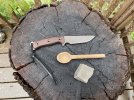- Joined
- May 9, 2002
- Messages
- 12,728
I'm not one who goes off into the wilds for months at a time. I barely have time to manage a few days once or twice a year.
That said, if I were going off and making a list of things I find crucial to carry and weight was an issue, I think I would rather have a Mora and a small flat diamond stone than anything convexed. Scandi grinds aren't bad to maintain with a bit of practice.
Now, since I am khukuri guy, I know a whole lot about a convex edge. It has been my preferred edge of choice for nearly 20 years. My suggestion would be a small piece of leather loaded with stropping compound. Make it a 4"x6" square that either fits in your back pocket or slides inside the pocket of your pocket. It weighs next to nothing and will maintain a razors edge as long as you strop the edge often between chopping and don't dull it completely before you touch it up. If you are packing a lower Rockwell hardness, a ding in an edge can be worked back into place with a hard rock. Damage to the edge of a traditional khukuri is generally burnished back into place with a piece of flat hardened steel.
I dont think any field maintenance can mimic a workbench full of specialty tools. IMHO, if you are trying to maintain an edge in the field, you are most likely trying to just keep the edge working and not optimal. Anything is better than nothing in that regard if you don't want to bring along the proper tools.
That said, if I were going off and making a list of things I find crucial to carry and weight was an issue, I think I would rather have a Mora and a small flat diamond stone than anything convexed. Scandi grinds aren't bad to maintain with a bit of practice.
Now, since I am khukuri guy, I know a whole lot about a convex edge. It has been my preferred edge of choice for nearly 20 years. My suggestion would be a small piece of leather loaded with stropping compound. Make it a 4"x6" square that either fits in your back pocket or slides inside the pocket of your pocket. It weighs next to nothing and will maintain a razors edge as long as you strop the edge often between chopping and don't dull it completely before you touch it up. If you are packing a lower Rockwell hardness, a ding in an edge can be worked back into place with a hard rock. Damage to the edge of a traditional khukuri is generally burnished back into place with a piece of flat hardened steel.
I dont think any field maintenance can mimic a workbench full of specialty tools. IMHO, if you are trying to maintain an edge in the field, you are most likely trying to just keep the edge working and not optimal. Anything is better than nothing in that regard if you don't want to bring along the proper tools.


